Chapter 4 A Venture with Pines
Early in the 1940's, after Ron and I had split up our partnership at West Scottsdale, I established two large commercial-type private nurseries in the area and sold hundreds of thousands of pine seedlings to the Forestry Commission.
To do this I bought ground at West Scottsdale, at the foot of the Blue Hills, from various owners, and a property, 'Lenna', opposite Northeast Park, in Scottsdale from Mr. Edmund Button. We sold the homestead and its surrounds and kept the remainder of the land for large-scale planting of pine trees. At that time there was some opposition to the planting of trees, many farmers believing there would not be enough good ground left for growing food.
It is interesting that now in 1990, everyone is becoming tree-conscious and this is wonderful. Yet in 1946 when I attended a farmers meeting, without exception they were very much against the planting of trees. When I entered the meeting (a bit late) all talk stopped and then I was told that I had been the centre of discussion. It was said that I would ruin the country by planting more trees when all the ground was needed for food production.
I pointed out that for the previous hundred years the tree lots of England had earned as much per hectare as farming and created just as much work. There were people present who later became closely involved with timber. This would not have been possible if I had not supplied the Forestry with seedlings and raised plantations myself.
In January 1984, Peg and I attended the 100th birthday celebrations of 'Lenna', hosted by Ron and Jill Harris. When my mother was a teenager she often spent weekends with the Button family at 'Lenna'. As mentioned earlier, Mr. Button was the only private person from whom I borrowed money; when I first started growing potatoes he lent me £5.
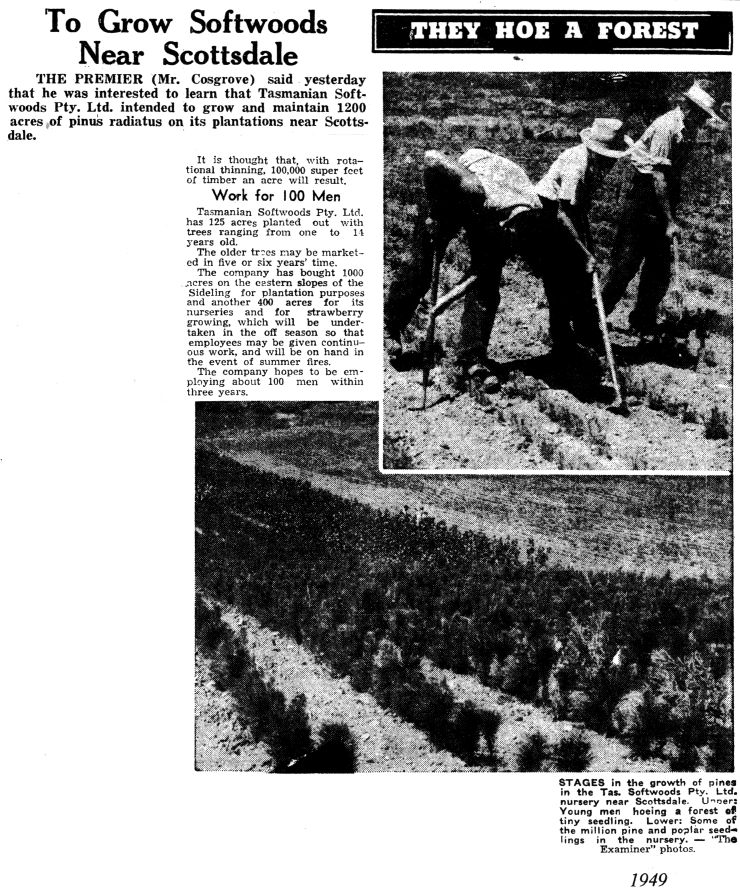
I am given a helping hand
I endeavoured to persuade the then Forestry Commissioner, Mr. Crane, to inoculate his pine seeds in the same way as clover seed, but he thought this was impractical. However, one of his officers did this on his own initiative in the North-East, and I also carried it out successfully. Before that time, bags of earth containing mycorrhiza fungi from under the pines had to be spread over the nurseries.
After we had planted about 300 acres of radiata pine trees a company was formed, with Sir Gordon Rolph, of the 'Examiner', as chairman, myself as managing director, and John Gunn, Harold Bushby and Donald McLennan directors.
This company was eventually sold, probably in the early 1960's, to the Board Mills for $98,000. I had retained about 80 per cent equity in the company, which was resold around about 1978 for $600,000 after some of the pines had already been cut. On a Forestry tour, a Commission officer said it was the best pine plantation in the state.
When the company was formed pamphlets were designed for use in selling contracts for one acre shares in the company, which was named Tasmanian Softwoods Ply Ltd. I researched, designed and wrote them myself. Before we sold the company and assets, we paid off all holders of contracts, and they made a reasonable profit from the transaction. In my various activities throughout my life everyone who invested money in any project I promoted gained by doing so, and no individual or section of the community was in any way disadvantaged.
Peg and I are proud of the fact that part of our present home was built of timber cut from trees grown from seed planted by me. This is not only unusual, but I believe almost unique. I sent over to South Australia for pine seeds, grew the seed in my nursery, planted out the seedlings, milled the timber when the trees had grown, and had part of our new home built from it. Feature walls look really good in this pine timber. We have other feature walls and the staircase built from timber grown on our property and leasehold areas and milled in our own sawmill. Celery top pine, myrtle and hardwood timbers used, although from our property, were not planted by me!
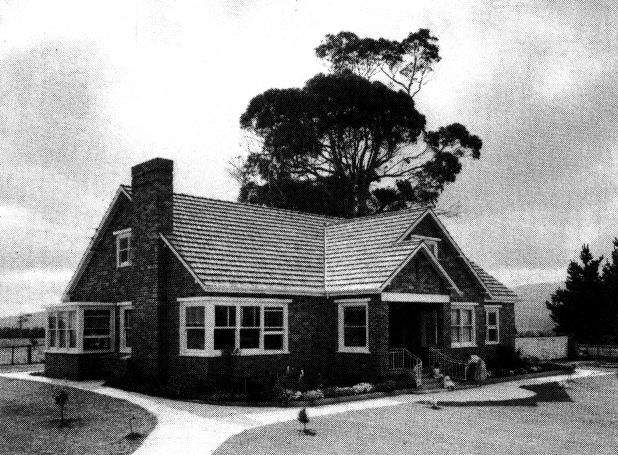
Our new home we built on our property at Scottsdale in 1951.
Peg, Mary and Jean on front steps.
Before anyone gets carried away by the fact that it is a great idea to plant a seed to grow your house, take note of my comments to visitors - 'It was very hard on my wife living in a hollow log and bringing up a family while the seed was growing into millable timber!'
Mr. Kevin French of French Enterprises, told me recently that it was fortunate I had planted out the pine plantations, which were the first major operation of this kind in Tasmania, as otherwise, with a Forestry Commissioner reportedly over-estimating the quantity of timber available in the area by 14,000 metres to Softwoods and 5000 metres to French Enterprises, their industry could have been in an uneconomic position.
As it is, however, by being able to buy in 5,000 metres a year for the next two years from my old plantation, now owned by Gunn's, they have been able to carry on with confidence.
After cutting more than $250,000 worth of timber from these plantations and replanting some of it, part has been sold for $500,000 and the balance sold for an extra $180,000. At the time of writing, we have three softwood mills operating in the North-East - two at Tonganah cutting board timber (board timber and general milling): S.E.A.S. Sapfor and French Enterprises Pty. Ltd., and a pine case mill at Branxholm. French Enterprises is unusual in that it is a private company and its progress has been spectacular.
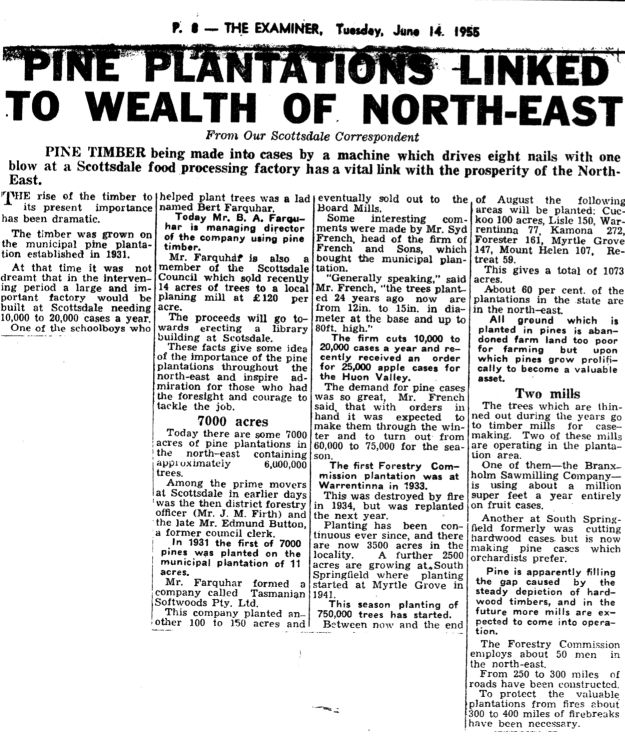
Examiner, June 14 1955
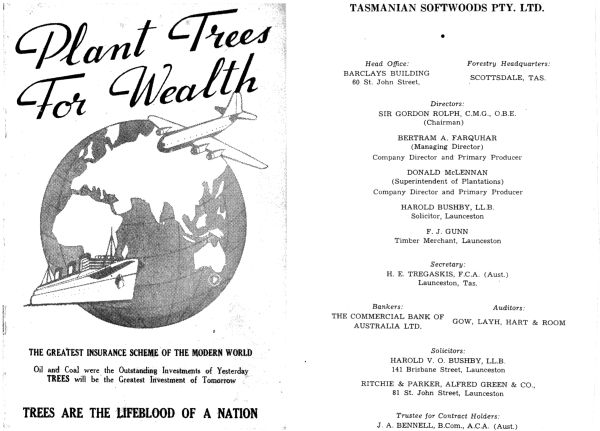
I designed and printed this book, plus pamphlet.
Help on th4 artwork on cover was given by my sister-in-law, Mal Bardenhagen.
The pamphlet caused considerable interest.
All predictions in booklet proved correct.
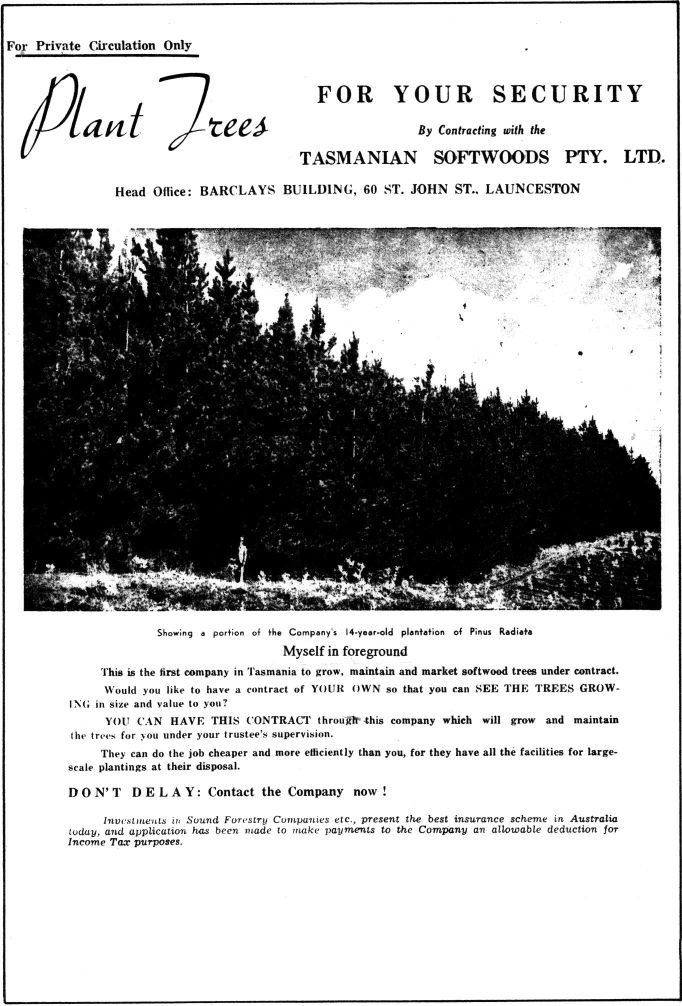
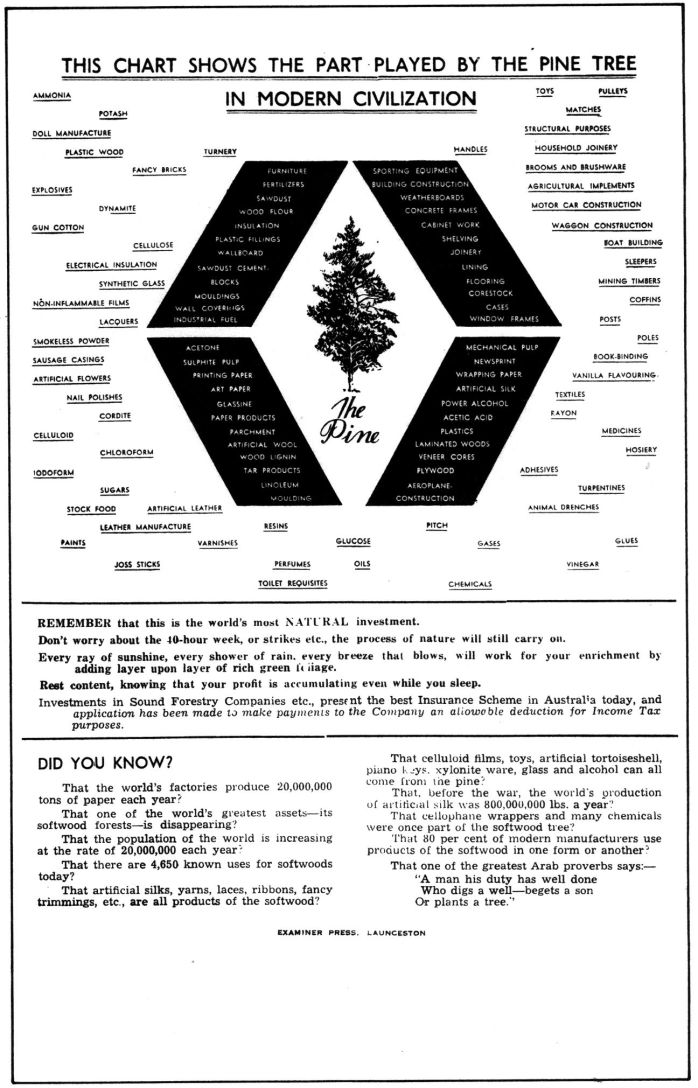
Forestry is not only a very important industry to Tasmania, but is of great importance to Australia and the world generally, so anything we do to promote tree plantings is worthwhile. In my booklet I noted that every £87 ($174) invested should bring in £500 ($1000) per acre at least. Although some people thought this optimistic the contracts actually yielded a higher financial return per acre. Throughout my life, while many people have considered me an optimist, my predictions have always been fairly accurate.
I just received in the mail a Victorian pamphlet on softwood plantations and the article expects the plantation to cost $1,760 per acre without land (ten times my total cost of establishment 43 years ago) and the estimated return by the year 2000 was $42,000 per acre. Therefore the cost increased, counting land, say by twenty times while estimated returns increased by forty odd times. I still believe planting of trees is a sound economic investment and a great asset to our country.
When I planted these trees I received a hostile reception from some farmers. People claimed it would have been better to have left the ground for farming purposes. However, it is a fact that a lot of the best ground for forestry is often of doubtful value for economic farming.
Now, fortunately, many more people are interested in planting trees.
Unfortunately the pioneers of any industry are not appreciated.
My old grandfather used to say, Never be the first one to start something new or the last to give up something old
.
This is sound advice - but someone has to be the first in everything.
Although my nurseries and tree planting may have been a first in it's category for Tasmania, I was not the first in the Farquhar Clan to engage in large scale forestry.
According to records a Farquhar/Farquharson chief in the early nineteenth century planted no fewer than sixteen million fir trees and two million larch on his estates in the Scottish Highland.
This must have been one of the biggest, if not the biggest private tree planting projects at that time in the world and even today would take some beating. Although the Farquharsons have always owned vast estates in Scotland, they look after their heritage responsibly.